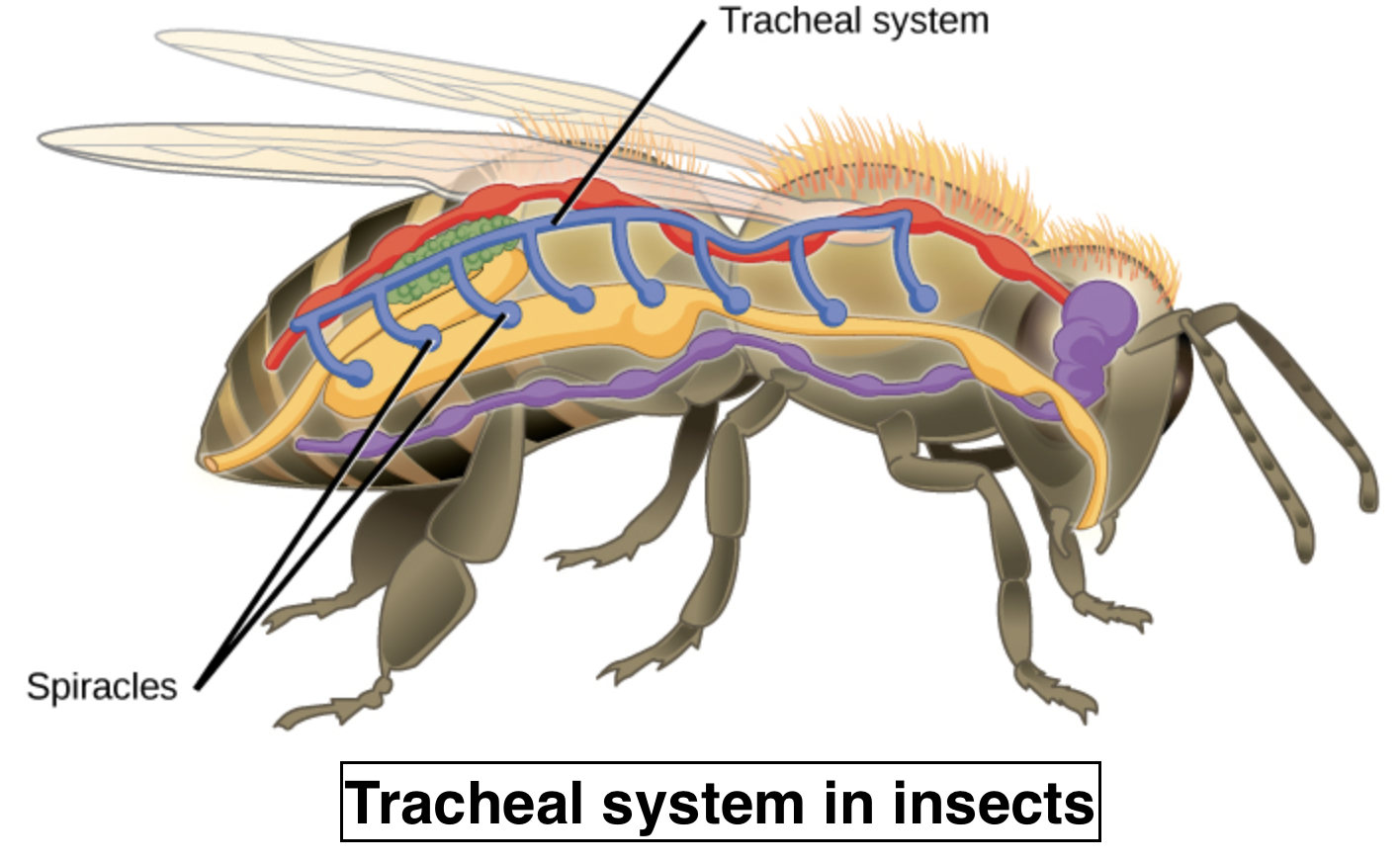
In general, insects respire through
A) Green glands
B) Malpighian tubules
C) Tracheal tubes
D) Stomodeal valves
Answer
477.3k+ views
Hint: It is an air-filled tube. They have an open connection with the outside air through an opening in their body wall. They are renewable because oxygen takes place by diffusion. Insects, centipedes, and arachnids use this type of system to breathe. It ensures the exchange of Oxygen and Carbon dioxide.
Complete step by step answer:
- Insects take in oxygen and give out carbon dioxide using an internal air tube known as tracheae. From the trachea the fine branches i.e the tracheoles pass to all parts of the body.
- The tracheae are lined with cuticles. When the insects moult, the linings of cuticles are shed off with other cuticles.

- There are two main pairs of lateral tracheae which run throughout the body, one on each side. In some insects, the lateral tracheae present on the dorsal and ventral side of the body.
- the tracheoles passed throughout the body from the main trunk. The track is open to the air at the paired spiracles.
- One pair per segment is present in the thorax and also in the first 9 abdominal segments. The tracheoles end within the body cells.
- by the diffusion method gases move within the trachea system. The ends of the tracheoles consist of fluid when the insect is less active.
- The end of the tracheoles, is the place where the fluid and gas meets i.e it is the interface between the fluid and gas, and the exchange of gases takes place.
- When the insect starts activity fluid removed from the tracheoles and the exchange of gases starts.
Additional information:
Green glands: these are the excretory organs of arthropods like crustaceans.This gland is also known as internal glands because they are located near the base of the larger antenna. It consists of three parts-end sac, Labyrinth, and bladder.
Malpighian tubules: it is also the type of excretory and osmoregulation system which is found in some insects, Arachnids, tardigrades, and myriapods.it has the branching tables which extend from the alimentary canal and from the surrounding hemolymph it absorb solutes, water, and wastes.
Stomodeal valve: it is a muscle that is present just behind the proventriculus and regulates the flow of food from the gizzard into the Midgut.
So, the correct answer is, "Tracheal tubes".
Note:
- The respiratory demand of the animal is not alone done by the diffusion process but also by the pumping actions of the body segments.
- The respiratory system of an insect is very efficient in small organisms. As the body size increases, the efficiency decreases.
Complete step by step answer:
- Insects take in oxygen and give out carbon dioxide using an internal air tube known as tracheae. From the trachea the fine branches i.e the tracheoles pass to all parts of the body.
- The tracheae are lined with cuticles. When the insects moult, the linings of cuticles are shed off with other cuticles.

- There are two main pairs of lateral tracheae which run throughout the body, one on each side. In some insects, the lateral tracheae present on the dorsal and ventral side of the body.
- the tracheoles passed throughout the body from the main trunk. The track is open to the air at the paired spiracles.
- One pair per segment is present in the thorax and also in the first 9 abdominal segments. The tracheoles end within the body cells.
- by the diffusion method gases move within the trachea system. The ends of the tracheoles consist of fluid when the insect is less active.
- The end of the tracheoles, is the place where the fluid and gas meets i.e it is the interface between the fluid and gas, and the exchange of gases takes place.
- When the insect starts activity fluid removed from the tracheoles and the exchange of gases starts.
Additional information:
Green glands: these are the excretory organs of arthropods like crustaceans.This gland is also known as internal glands because they are located near the base of the larger antenna. It consists of three parts-end sac, Labyrinth, and bladder.
Malpighian tubules: it is also the type of excretory and osmoregulation system which is found in some insects, Arachnids, tardigrades, and myriapods.it has the branching tables which extend from the alimentary canal and from the surrounding hemolymph it absorb solutes, water, and wastes.
Stomodeal valve: it is a muscle that is present just behind the proventriculus and regulates the flow of food from the gizzard into the Midgut.
So, the correct answer is, "Tracheal tubes".
Note:
- The respiratory demand of the animal is not alone done by the diffusion process but also by the pumping actions of the body segments.
- The respiratory system of an insect is very efficient in small organisms. As the body size increases, the efficiency decreases.
Recently Updated Pages
The correct geometry and hybridization for XeF4 are class 11 chemistry CBSE

Water softening by Clarks process uses ACalcium bicarbonate class 11 chemistry CBSE

With reference to graphite and diamond which of the class 11 chemistry CBSE

A certain household has consumed 250 units of energy class 11 physics CBSE

The lightest metal known is A beryllium B lithium C class 11 chemistry CBSE

What is the formula mass of the iodine molecule class 11 chemistry CBSE

Trending doubts
State the laws of reflection of light

Arrange Water ethanol and phenol in increasing order class 11 chemistry CBSE

One Metric ton is equal to kg A 10000 B 1000 C 100 class 11 physics CBSE

Difference Between Prokaryotic Cells and Eukaryotic Cells

A mixture of o nitrophenol and p nitrophenol can be class 11 chemistry CBSE

How do I convert ms to kmh Give an example class 11 physics CBSE




